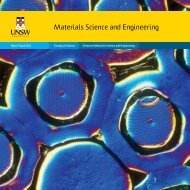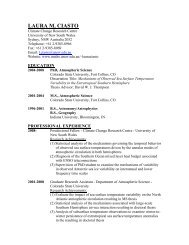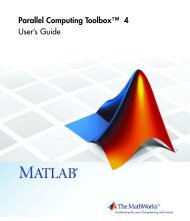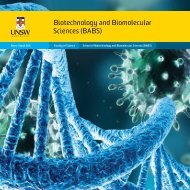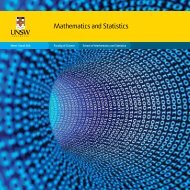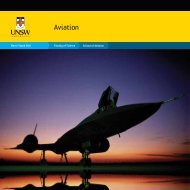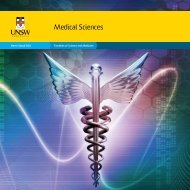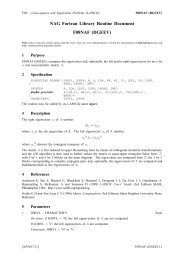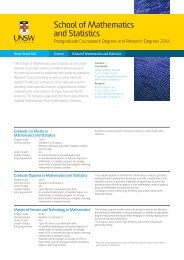2011 Postgraduate Research Competition - UNSW Science - The ...
2011 Postgraduate Research Competition - UNSW Science - The ...
2011 Postgraduate Research Competition - UNSW Science - The ...
You also want an ePaper? Increase the reach of your titles
YUMPU automatically turns print PDFs into web optimized ePapers that Google loves.
Page |16<br />
Quantum Properties of Near-Black Hole Objects<br />
Graeme Gossel and Victor Flambaum<br />
School of Physics<br />
Abstract<br />
We present results of calculations involving bound and unbound scalar particles in the<br />
gravitational field of a central body that is near the threshold of being a black hole.<br />
In the bound particle case we find that only in the limit that the body tends to the black hole<br />
case is an energy level with zero energy possible. As this is a necessary, but not sufficient,<br />
condition for Hawking radiation this implies that Hawking radiation is not possible around<br />
such non-singular static bodies. Given that ‘pure’ black holes require infinite time to form and<br />
these limiting cases do not permit Hawking radiation, does Hawking radiation exist in nature<br />
In the unbound particle case we find a new spectrum of dense and narrow resonances.<br />
<strong>The</strong>se resonances represent long lived quasi-bound states of the particle. As the black hole<br />
limit is approached, the distribution of these states becomes denser and the delay times<br />
become larger. This dense spectrum of long lived states gives rise to effective absorption of<br />
the particle. Thus as the central body approaches the black hole threshold, so it smoothly<br />
acquires a black hole-like absorption spectrum; an object that is not yet a black hole may<br />
look like one.<br />
Abstract<br />
Particle dynamics in an annular shear cell<br />
Xing Wang and Aibing Yu<br />
School of Materials <strong>Science</strong> & Engineering<br />
Mechanical and rheological properties of solid flow in an annular shear cell are investigated<br />
by a series of discrete particle simulations of slightly polydispersed spheres from quasi-static to<br />
intermediate regimes. <strong>The</strong> parametric study shows that the normal pressure, shear velocity,<br />
particle friction coefficient and rolling friction coefficient have noticeable influences on the<br />
microdynamic variables such as porosity and coordination number. <strong>The</strong> overall coordination<br />
number and density are found to collapse on a linear master curve, with an applicable<br />
coordination number between 5 and 6.5. <strong>The</strong> deviation from the relation may be related to<br />
the significant changes in the probability distribution of the scaled contact force. A linear<br />
relationship between the (internal/external) shear and normal stresses prevails in the shear<br />
cell and the internal and external friction coefficients can compare well with each other. <strong>The</strong><br />
so-called I-rheology is rigorously tested in this cell system. Our results unambiguously display<br />
that the I-rheology can effectively describe the intermediate flow regime, with an empirical<br />
fit obtained for the present annular shear cell system. However, significant deviations take<br />
place when it is applied to the quasi-static regime which corresponds to very small values of<br />
inertial number.<br />
cutting-edge discovery science|



